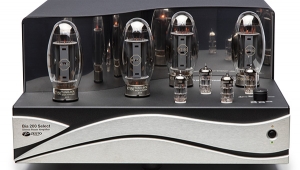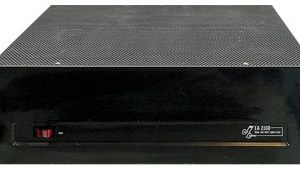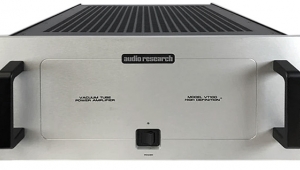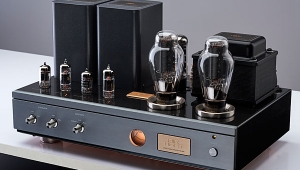| Columns Retired Columns & Blogs |
Antique Sound Lab Explorer 805 DT monoblock power amplifier Letters
The following letters appeared in May 2004 (Vol.27 No.5):
The Explorer amplifier
Editor: I immensely enjoyed Art Dudley's review of the ASL Explorer 805 DT monoblock amplifier in March. Extremely impressive, and tempting.
John Atkinson may not know that a parallel-fed design can tune the output capacitor and transformer to peak out in the bass exactly as his curves show. It is not necessarily a feedback phase-shift scenario. May I also suggest that JA's final footnote should have read "Compressed transient peaks relax the psychoacoustic into perceiving greater low-level timbral detail and die-away, exactly as Art observed." JA should know that "instantaneous harmonics" are imperceptible, as at least 11 milliseconds duration is needed even for young, alert people to notice them. Finally, Art, it is a slur when acoustic feedback is called "amplifier oscillation." They sound similar only to the inexperienced.
I hope that this letter doesn't seem too arrogant, but I have been scratch-building and selling my own designs of tube amps and speakers, weighing up to 90 and 110 lbs, respectively, since 1958.—Jim Carlyle, subscriber, New Zealand (with the Hobbits) chrisjim@e3.net.nz
The Shishido amplifier
Editor: As a hobbyist-designer-builder of SET amps familiar with the designs of the late Nobu Shishido, I would like to share some insight as to the behavior of the Explorer 805 DT amplifier, sonically and electrically.
First, it is a loosely appropriated Shishido design from his book, published only in Japanese a couple of years before his death. It is similar to the WAVAC designs, not just because it uses an interstage transformer, but because it wrings more power from the output tube than should be possible from a SET amp. That value is 25% or less of the tube's plate dissipation (125W for the 805). One would expect about 30W output from this tube.
Shishido used a class-A2 arrangement with positive grid voltage and current to dramatically reduce the plate resistance of the tube and increase the power output. The price was rapidly rising distortion after a watt or so. His idea was that the "first watt" was what really mattered for sound quality, and the rest was dynamic headroom. As long as clipping was avoided, a rising distortion wouldn't sound bad on peaks. Indeed, the 1W distortion is the classic evenly falling harmonic progression described by Jean Hiraga as pleasant and natural in character. The progression to 10% THD at full power is typical of this class of Shishido's amps, as depicted in his book. He also used a little feedback, often cathode feedback to the output tube, but also a little global feedback to tighten up the sound of these amps.
Nobu Shishido didn't use parallel feed in his designs that I know of. This amp does feed the output tube through a plate-loading choke, and capacitor-couples the output transformer to save it from a huge current flux that would hurt its performance or require it to be much larger and more complex. In "parafeed" designs such as this, the value of the capacitor coupling the output tube to the transformer is critical for stable operation. It determines the Q, or damping factor, of the tube-cap-transformer unit. Too small a cap gives an undamped resonance that may even be up in the audio range. This cap is so sub-optimal that the amp oscillates without feedback, something that no SET amp should typically do. The cap probably needs to be fully 10 times as big for this application. That might be bigger and more expensive than could be worked into the price-point concept of this design. It is also unlikely that it could be added later without grossly carving up the amp.
To emulate Nobu Shishido certainly shows a degree of sophistication, but to do so without attribution is not a positive sign. WAVAC makes the Music Dandy Shishido amp to a more refined standard in the same price range, and gives credit where credit is due.—John Day, Austin, TX, dayfamily6@earthlink.net
- Log in or register to post comments



































